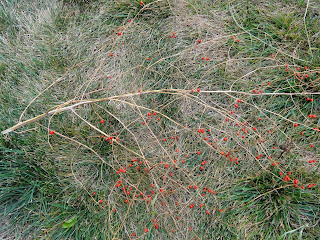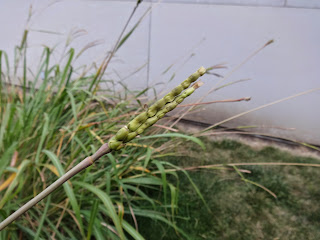Sunday, August 31, 2014
gamagrass and potato seeds?
four weeks ago ( top photo ) the gamagrass was upright and most of the seed was green..today ( second photo ) the leaves, spears , and seed heads are lowered to the ground and most of the seed heads are shattered ( even though there are still green seeds out there..the immature seed heads are the ones closest to an upright position ) scattering seed as far away as possible form the parent plants...the third photo is of n early blue potato plant that had been flowering on my last trip out..when i looked on the underside i found what looks like seed pods ( i have been working with jerusalem artichoke seeds at home trying to see if they are actually viable or vestigial and so seeds have been on my mind...i was discussing wild potatoes that i have grown from seed and wondered aloud if domesticated potatoes produced seed [which it seemed they should even if they were not viable either ] which is why i looked in the first place 0 i cannot find anything in the way of an image of a domesticated potato seed pod...yet...i will continue looking and i will refrain from harvesting these spuds until these seed pods ( or whatever 0 ripen.
Sunday, August 17, 2014
spuds and seeds
the top photo is of today's haul of spuds out of the pgp...after i got home i cleaned them up and found i had just a shade more than another pound-and-a-half of potatoes ( these are yukon golds )..lots of potatoes are finishing up..but not the seemingly misnamed early blue...they are still flowering ( both here and in the community garden )...they are easily pursuing as long a season as the did in the basement ( and will again in a few months i am assuming )...they will finish when they are ready...the bottom photo is some asparagus seed that is cooked completely and ready to plant...each "berry" has three to five seeds ( as i discovered when i germinated and grew them in the basement during the winter of 2012-2013...the all died when i tried to transplant them ) and should be directly seeded this autumn to overwinter and hatch out next spring...some of these ( if not all..there are many more cooking ) are going to find there way west to our community garden's friend ( and, by extension, a friend of the pgp )fern...she had a look in on the pgp while she was visiting friday and i offered to send her some...they will be going soon.
i have heard from mary eubanks...
...who, despite her own students and research, has always taken time to answer my questions...so thank you dr. eubanks for your time and consideration...she tells me that water stress shouldn't have an impact on the gamagrass because, 1) it is highly drougth resistant and, 2) it has notoriously low fertility anyway...i know that empirically ...i planted thirty seeds in the pgp in the fall of 2009 and three germinated...ten percent of the seeds became this stand ( another grass that i am uncertain of establishing again )...the seed heads are shattering cyclically...some have finished, others are still green...i have been collecting seed as i can in hopes of finding a space not controlled by the university ( my yard one would suppose...but even then... ) we'll see what becomes of perennial projects if i cut down some trees ( something else that goes against my better judgement )...the bottom photo is of the pgp about 7:15 this morning...still out there.
tomatoes and teosinte
in a perverse mood last spring i put annual tomatoes in a perennial garden...mostly because i wanted to grow some and because there are no ecosystems with only perennial plants so that aint natural...it has been a coolish summer and the larger tomatoes are stalled just about everywhere from the pgp to my back yard and beyond..one is making an effort at ripening on the vine but past the cherry tomatoes i'm not to sure how much of that we will see anywhere hereabouts this season...the zea diploperennis is doing just fine and i don't want to miss an opportunity to put some photos out there...i have no real idea where or when i will be establishing another stand or if it will ever be as successful as this now four year old stand of a sub tropical grass that has withstood three winters here was ( is...it's got a few more months yet...more photos soon )
Sunday, August 10, 2014
water stress II
it's been a few hours since my trip out o campus this morning and i had a quiet moment to have a closer look at the seeds i retrieved from the ground around the gamagrass plants this morning...i picked them up, took a photo , and jammed them in a pocket without really taking a close look...a more detailed inspection reveals that they are hollow...something i haven,t run across before but which may be normal...or not...admittedly a small sample...but they were from different plant sin the stand and that may count for something...i have an email out to dr. mary eubanks at duke...she knows more about gamagrass than i do ...hopefully she will shed some illumination...more as it comes in.
water stress
after an inordinately wet june the summer has dried out...i believe i covered what i was watering and what i wasn't and why in an earlier post...the gamagrass was in the "not watering" column and it is beginning to show signs of serious water stress...yellow and brown leaves everywhere ( which is probably alright since the univeristy wants it dead anyway ) and the stems with the seed heads have begun to lower to the ground, extending the seed as far as possible from the parent plant...but the seed, for the most part, is still green and not nearly ready to shatter...so the mechanism is probably responding to a dearth of water rather than the season's true end...there is rain in the forecast but i don't know how far that will go in reversing the plants' attempt to disperse seeds...i did retrieve some mature seed from the ground...but the maturation of the seed is cyclical anyway...some is done which isn't surprising since seed production has been going on since june...older heads shatter first...there seems to be a climatological glitch in the system...it's a native so it should be adapted to the climate...but it seems to be hurrying the season along.
Thursday, August 7, 2014
out of the pgp
another trip to campus...another harvest...purple valley out front...red potiacs on the right and yukon gold left...the yukon golds seem to grow even closer to the surface of the soil than other varieties...even when i hill them several times a season they pop out...you can see one has "greened" from exposure to sunlight...that's solanine and it can be toxic if you eat enough..i will be cutting the green out before eating...another 2 1/2 pounds and the harvest is only about half over...some plants are still blooming...it is a bumper crop of spuds everywhere this season...hope yours are good too.
Sunday, August 3, 2014
first spuds from the pgp since 2010
when this project was in the planning stage and kathy and i came down from being high as kites at the possibilities ( an academic easily as over the top as i am...a dangerous combination ) and began a somewhat serious discussion of what to put in the graden potatoes were a natural...they are a plant/replant perennial and they are native to the andes...kathy did a lot of research work in peru and so they were an early and definite choice...red nordlands are what went in that spring...when they finished up kathy was in florida so she never got any of that particular produce...you can't ( or, at least shouldn't ) plant potatoes in the same spot year after year ...pathogens build up in the soil and pests have an easier time vectoring in on the spuds...you need at least a three year rotation and , according to steve brush, some traditional systems only plant fields in potatoes every seven years, rotating with mashua, yakon, and oka...so for the last season...and after a four year gap between plantings, i planted a variety of spuds for the garden's last season...some of those plants are still flowering ( see facebook ) while some have finished...i harvested 4 1/2 pounds of red pontiacs, craigs' snowwhites, yukon golds, and purple valley tubers this morning and remembering better times in the garden.
eastern gamamgrass
there are seed heads all over the gama grass stands and it looks as if there may be more developing...the seeds on the seed heads and those that i found on the ground still look a little to green to be shattering...not quite ripe...this is a forage crop and i am told that 1) there are deer that roam the campus when it's quiet ( not hard to believe with the river nearby )...and, 2) deer are pigs for gamagrass seeds...so does that seed head in the third photo look shattered or gnawed to you?
Subscribe to:
Posts (Atom)





































